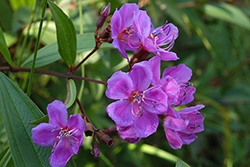e-Flora of Thailand
Volume 7 > Part 3 > Year 2001 > Page 444 > Melastomataceae > Melastoma
6. Melastoma pellegrinianum (H.Boissieu) Karst.Meyerwfo-0000158050
Blumea 46: 374. 2001.— Dissotis pellegriniana H.Boissieu, Bull. Soc. Bot. France 59: 331. 1912; Guillaumin in Lecomte, Fl. Gén. I-C. 2: 894. 1921.
Accepted Name : This is currently accepted.
Synonyms & Citations :
Description : Shrub, 1–1.5(–2.5) m tall, branchlets quadrangular and covered with appressed brown hairs. Leaves lanceolate, 8–10(–12) x 2.5–5 cm, base cuneate to subacute, apex acute, lamina with 2–3 pairs of lateral primary veins, strigose on both sides, petioles ca 1 cm long. Inflorescences terminal many-flowered leafy paniculate cymes. Flowers 5 merous, bracts ca 8 mm long, externally villous. Hypanthium 5–7 mm long, covered with sparse, simple, short appressed bristles; calyx lobes lanceolate, 5–7 mm long. Petals 10–14 mm long, pinkish-purple. Stamens 10, dimorphic, purple or dark blue, outer anthers about 9 mm long, connective prolongation 8–10 mm long, inner anthers about 8 mm long, connective not prolonged. Ovary apically setose. Dry capsule 6–9 mm long.
Thailand : EASTERN: Si Sa Ket, Ubon Rachathani; CENTRAL: Saraburi, Nakhon Nayok; SOUTH-EASTERN: Trat (Ko Chang, Klawng Kloi, 50 m – type of Melastoma acutisepalum: Kerr 9244 -BK).
Distribution : Laos, Cambodia, Vietnam (type).
Ecology : On rocky ground or cliffs in mixed evergreen and deciduous forests, also in open thickets on sandy soil or in savannas, up to 600 m alt.
Vernacular : Khlong khleng phon haeng (โคลงเคลงผลแห้ง).
Notes: Dissotis as presently circumscribed is endemic to Africa, and the Asiatic 'Dissotis' pellegriniana is better placed in Melastoma, which is also indicated by molecular data (Renner and Meyer, Evolution 55: 1315–1324. 2001). The species can be identified by the terminal, many-flowered inflorescences unusual among its congeners and dry capsular fruits.

